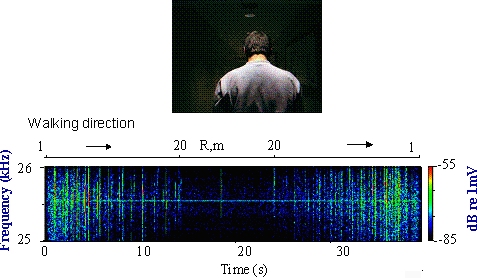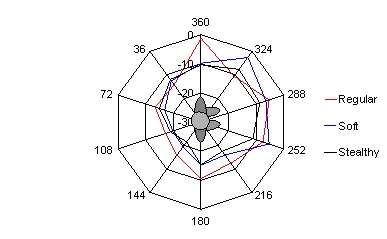
[ Lay Language Paper Index | Press Room ]
Alexander Ekimov - aekimov@olemiss.edu
James M. Sabatier
NCPA, University of Mississippi
University, MS 38677
Popular version of paper 4aPA9
Presented 10:00 a.m. Friday Morning, November 30, 2007
154th ASA Meeting, New Orleans, LA
Video file (download)
The human footstep produces a wide range of frequencies in the air due to the force of friction between the foot and the ground. Isolating the high frequencies in the footstep's sound makes signal measurement and analyses of footsteps possible, even in the presence of high levels of background noise at low frequencies (e.g. in urban areas).
Typically, the noise around us mostly consists from the low frequency sound, with fewer sounds in the higher frequencies. To take high-frequency measurements, a narrow band microphone with maximum sensitivity at ultrasonic frequencies from 25-26 kHz was used. The microphone was less sensitive to lower frequencies of sound. A demonstration of this method is presented in Figure 1. The ultrasonic detector was able to detect the footstep signals in the presence of loud music. In this test, a person started walking at 1 meter from the detector location and stopped walking at 20 meters from this sensor. The person stopped for 10 seconds and then walked back to the starting position.
 |
| Figure 1. Footstep sound signature (spectrogram) in a building hallway. The sampling rate was 88.2 kHz and the FFT size was 16,384. |
In outdoors tests on the ground an ultrasonic (25-26 kHz) footstep signal was detected at a distance of 17 meters from the walker. Another aspect of footstep sound characterization is a directivity pattern. The sound wavelength at those frequencies corresponds to 13-14 mm, which is much less than the size of the source (approximately the size of a foot, 300 x 120 mm). The results of the experimental investigations are presented in Figure 2.
 |
| Figure 2. Azimuthal diagram of sound pressure in dB re: 20 micro Pa at a distance range of 5-7 meters from the walker of ten regular, soft, and stealthy footsteps on the ground. The sampling rate was 64 kHz and the FFT size was 4096. The noise floor was -24 dB re 20 micro Pa. |
An analysis of tests results shows that a footstep does not sound the same from every direction. A maximum value of the pattern (loudest) corresponds to the direction of walking while the minimum value (softest) is in the opposite direction.